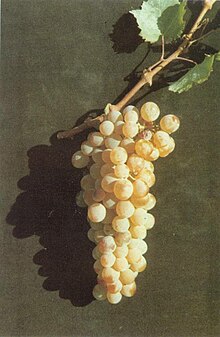Assyrtiko
| Assyrtiko | |
|---|---|
| Grape (Vitis) | |
 | |
| Color of berry skin | Blanc |
| Species | Vitis vinifera |
| Also called | see list of synonyms |
| Origin | Santorini |
| Notable regions | Greece |
| VIVC number | 726 |
Assyrtiko or Asyrtiko is a white Greek wine grape indigenous to the island of Santorini. Assyrtiko is widely planted in the arid volcanic-ash-rich soil of Santorini and other Aegean islands, such as Paros. It is also found on other scattered regions of Greece such as Chalkidiki.[1] Assyrtiko is also being grown by the Paicines Ranch Vineyard in the San Benito AVA of California with Margins Wine making the wine,[2] by Jim Barry Wines in Clare Valley, South Australia,[3] at the Abbey of New Clairvaux in Northern California since 2011, and at Kefi Winery in Monroe, North Carolina by a first generation Greek family.[4] The original Assyrtiko cuttings were imported in the USA in 1948 by Harold Olmo, grape breeder at the University of California, Davis, where they were stored until the abbey of New Clairvaux took interest in the early 2000s.[5]
On Santorini, many old vine plantations (over 70 years of age) of Assyrtiko exist, of which many are non-grafted. These plantations have shown resistance to Phylloxera. As the only European grape vine known to be resistant to wine blight, there is speculation that the actual source of this resistance may arise from the volcanic ash in which the vines grow, and not from the vine itself.[6]
Wine style
[edit]The mineral profile of the grape bodes well for blending and in recent times it has been blended often with Sauvignon blanc, Sémillon and Malagousia.[1] Assyrtiko grapes clusters are large, with transparent yellow-gold skin and juicy flesh. In the volcanic soil of Santorini, there appear to be some unique characteristics that develop in the grape variety, and therefore in the wine. One of these characteristics is that Assyrtiko does not lose its acidity even if it is very ripe. Throughout Greece, the grape is vinified to make a variety of dry and sweet wines, including Vinsanto-like musky and syrup-sweet dessert wines. In Retsina, it is often blended with the less-acidic Savatiano grape.[7]
Synonyms
[edit]Assyrtiko is also known under the synonyms Arcytico, Assirtico, Assyrtico, Asurtico, and Asyrtiko.[8]
References
[edit]- ^ a b J. Robinson (ed) "The Oxford Companion to Wine" Third Edition pg 37 Oxford University Press 2006 ISBN 0-19-860990-6
- ^ Asimov, Eric (12 May 2022). "Are Sheep a Crucial Ingredient for Vineyards and Ecosystems?". The New York Times. ISSN 0362-4331. Retrieved 24 August 2023.
- ^ "Jim Barry Wines produces first Australian Assyrtiko". 16 November 2016.
- ^ "Kefi Vineyards & Winery | Monroe, NC | Vineyards and Farms". 12 August 2018. Retrieved 20 June 2021.
- ^ Mike Dunne, Dunne on Wine: Greek grapes take root in Tehama County, Sacbee.com, 2 August 2017
- ^ Thom Elkjer Adventures in Wine: True Stories of Vineyards and Vintages Around the World. Travelers' Tales, 2002. ISBN 1-885211-80-5
- ^ J. Robinson Vines, Grapes & Wines pg 261 Mitchell Beazley 1986 ISBN 1-85732-999-6
- ^ Assyrtiko, Vitis International Variety Catalogue, accessed 2010-11-23
